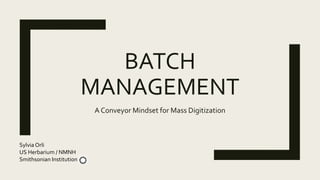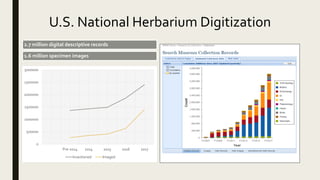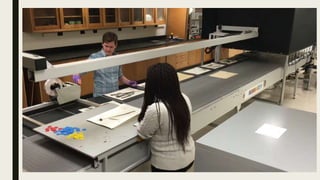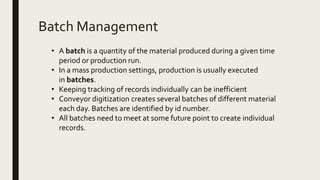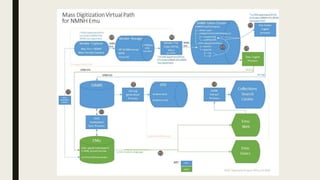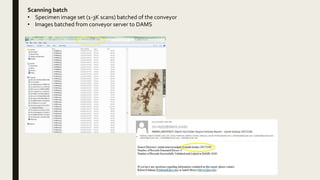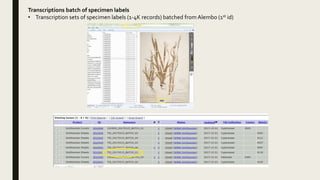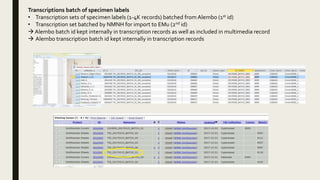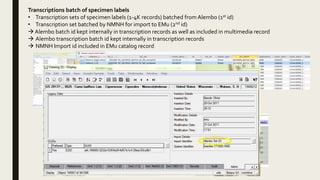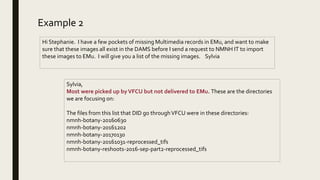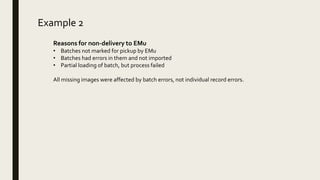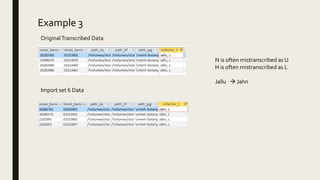Batch Management: A Conveyor Mindset for Mass Digitization
- 1. BATCH MANAGEMENT A Conveyor Mindset for Mass Digitization Sylvia Orli US Herbarium / NMNH Smithsonian Institution
- 3. 2.7 million digital descriptive records 1.6 million specimen images 0 500000 1000000 1500000 2000000 2500000 3000000 Pre-2014 2014 2015 2016 2017 Inventoried Imaged U.S. National Herbarium Digitization
- 8. Batch Management ŌĆó A batch is a quantity of the material produced during a given time period or production run. ŌĆó In a mass production settings, production is usually executed in batches. ŌĆó Keeping tracking of records individually can be inefficient ŌĆó Conveyor digitization creates several batches of different material each day. Batches are identified by id number. ŌĆó All batches need to meet at some future point to create individual records.
- 10. Alembo transcribes Specimen Labels transcribed by Alembo Picturae batches label transcriptions in sets of 4000 and does preliminary review NMNH Botany reviews label transcriptions at 2.5% check Accepted Label Transcription Sets added to Master Transcription SQL db Batches of 30,000-40,000 transcription created from master SQL db; all records in batch reviewed for import to EMu Rejected Sets returned to Picturae for correction Alembo transcribes cover taxonomic names; EMu taxonomic irns added if in picklist Picturae batches cover transcriptions in sets of 100-4000 and does preliminary review NMNH Botany reviews label transcriptions and adds missing EMu irns Taxonomic irns added to import batches Import scripts run on import batch Import to EMu Botany Conveyor Project: Transcription Workflow
- 11. Conveyor Batches Scanning batch ŌĆó Specimen image set (1-3K scans) batched of the conveyor ŌĆó Images batched from conveyor server to DAMS ’āĀbatch id follows image from conveyor to EMu multimedia record Transcriptions batch of specimen labels ŌĆó Transcription sets of specimen labels (1-4K records) batched from Alembo (1st id) ŌĆó Transcription set batched for import to EMu (2nd id) ’āĀ Scanning batch id kept internally in transcription records as well as included in multimedia record ’āĀ Alembo transcription batch id kept internally in transcription records ’āĀ Import id included in EMu catalog record Transcription batches of folder labels/ taxonomy ŌĆó Transcription sets of folder labels (400-2000 records) batched from Alembo ŌĆó Folder label records are assigned EMu taxonomy irns ŌĆó IRNs assigned to individual records in transcription import batch ’āĀ Scanning batch id kept internally in transcription records
- 12. Scanning batch ŌĆó Specimen image set (1-3K scans) batched of the conveyor
- 13. Scanning batch ŌĆó Specimen image set (1-3K scans) batched of the conveyor ŌĆó Images batched from conveyor server to DAMS
- 14. Scanning batch ŌĆó Specimen image set (1-3K scans) batched of the conveyor ŌĆó Images batched from conveyor server to DAMS ’āĀbatch id follows image from conveyor to EMu multimedia record
- 15. Transcriptions batch of specimen labels ŌĆó Transcription sets of specimen labels (1-4K records) batched from Alembo (1st id)
- 16. Transcriptions batch of specimen labels ŌĆó Transcription sets of specimen labels (1-4K records) batched from Alembo (1st id) ŌĆó Transcription set batched by NMNH for import to EMu (2nd id) ’āĀ Alembo batch id kept internally in transcription records as well as included in multimedia record ’āĀ Alembo transcription batch id kept internally in transcription records
- 17. Transcriptions batch of specimen labels ŌĆó Transcription sets of specimen labels (1-4K records) batched from Alembo (1st id) ŌĆó Transcription set batched by NMNH for import to EMu (2nd id) ’āĀ Alembo batch id kept internally in transcription records as well as included in multimedia record ’āĀ Alembo transcription batch id kept internally in transcription records ’āĀ NMNH Import id included in EMu catalog record
- 18. Transcription batches of folder labels/ taxonomy ŌĆó Transcription sets of folder labels (400-2000 records) batched from Alembo ŌĆó Folder label records are assigned EMu taxonomy irns
- 19. Transcription batches of folder labels/ taxonomy ŌĆó Transcription sets of folder labels (400-2000 records) batched from Alembo ŌĆó Folder label records are assigned EMu taxonomy irns ŌĆó IRNs assigned to individual records in transcription import batch ’āĀ Scanning batch id kept internally in transcription records
- 20. Why does this matter? ŌĆó Important management tool ŌĆó Important for tracing errors and issues
- 21. Hi Sylvia, I just finished reviewingTSI_20160825_BATCH_01_MS. Overall, I would probably accept this batch, but there was another issue I noticed. Several chunks of records do not have working JPG links, and I could not locate the barcodes in the correctly dated folders or just in the JPG file in general. So I am not sure where the images went for these records. There are complete transcriptions recorded for them, but IŌĆÖm not sure how to check them with the images. Here were the records with issues: ID # 138-403 (Folder dates: 02/05, 07/15, 01/29) ID # 1154-1330 (Folder dates: 01/29, 07/22, 02/05) ID # 1395-1458 (Folder dates: 02/05) ID # 1483-1533 (Folder dates: 02/05, 06/16, 07/15) So it looks like the problematic dates are: 01/29, 02/05, 06/16, 07/15, and 07/22. Example 1
- 22. Everyone, We have multiple image groups that are not in DAMS and theVFCU reports. All the dates are Fridays with one exception. It looks like the problematic dates are: 01/29, 02/05, 06/16, 07/15, and 07/22. For example on 7/15 we are missing the Tiff/Iiq 01842476 From the VFCU for 7/15 I can see the last image on that day was ŌĆ£01842475ŌĆØ but the sequence does not pick up the following day of production on 7/18. However there is a transcribed image that we canŌĆÖt see nor can we find a deliverable on the picturae server. - Could this be a permission issue? - A batching error? - How are the jpgs created ŌĆō from the IIQ or TIF or at the point of capture? We are working on creating a list of everything we donŌĆÖt have deliverables for from TSI_20160825_BATCH_01_MS Our concern is that there are many other dates besides the ones I outlined above which we only discovered due to transcription checking.
- 24. Example 2 Hi Stephanie. I have a few pockets of missing Multimedia records in EMu, and want to make sure that these images all exist in the DAMS before I send a request to NMNH IT to import these images to EMu. I will give you a list of the missing images. Sylvia
- 25. Example 2 Hi Stephanie. I have a few pockets of missing Multimedia records in EMu, and want to make sure that these images all exist in the DAMS before I send a request to NMNH IT to import these images to EMu. I will give you a list of the missing images. Sylvia Sylvia, Most were picked up byVFCU but not delivered to EMu. These are the directories we are focusing on: The files from this list that DID go throughVFCU were in these directories: nmnh-botany-20160630 nmnh-botany-20161202 nmnh-botany-20170130 nmnh-botany-20161031-reprocessed_tifs nmnh-botany-reshoots-2016-sep-part2-reprocessed_tifs
- 26. Example 2 Reasons for non-delivery to EMu ŌĆó Batches not marked for pickup by EMu ŌĆó Batches had errors in them and not imported ŌĆó Partial loading of batch, but process failed All missing images were affected by batch errors, not individual record errors.
- 27. Example 3
- 28. Example 3
- 29. Example 3
- 30. Example 3 OriginalTranscribed Data Import set 6 Data N is often mistranscribed as U H is often mistranscribed as L Jallu ’āĀ Jahn
- 31. In conclusionŌĆ” ŌĆó Mass digitization is mass production, and should be managed as such in batches ŌĆó Patterns are constant in large amounts of data ŌĆó Always look at the forest when thinking about the trees
Editor's Notes
- #4: We significantly increased our rate of digitization and now have over 2.398 million digital descriptive records and 1.4 million specimen images. The conveyor belt has imaged over 1 million specimens, with 900,000 records being transcribed to create digital descriptive records. The remaining 100,000 were specimens that had previously been inventoried and were simply imaged on the conveyor belt. This has been a great way for us to significantly increase our rate of digitization, and with an estimated 5 million pressed specimens in our collection, it is moving us towards our ultimate goal of a completely databased and imaged herbarium collection.

